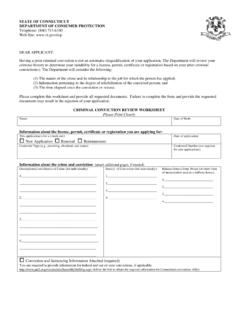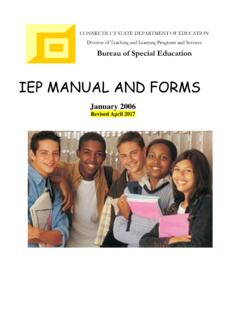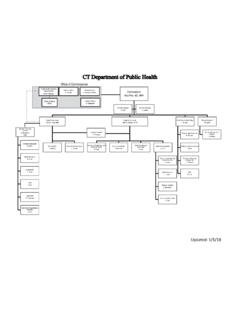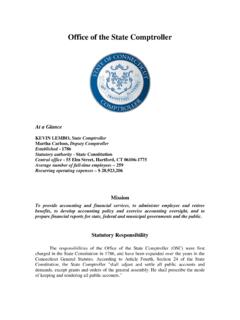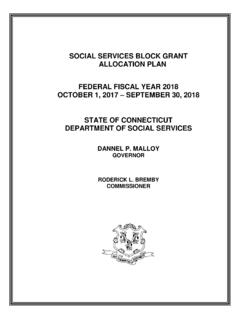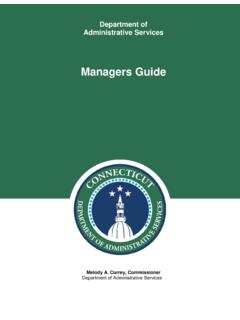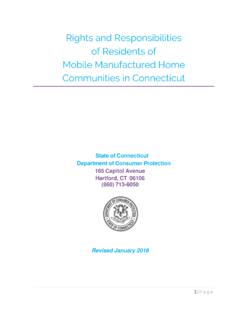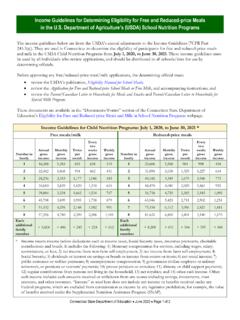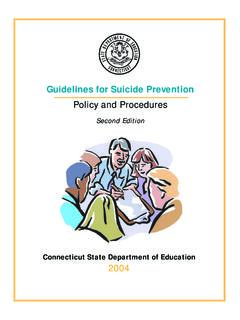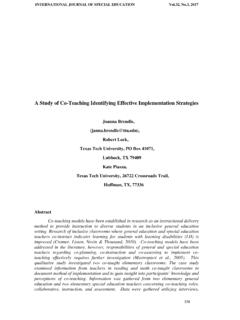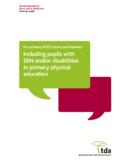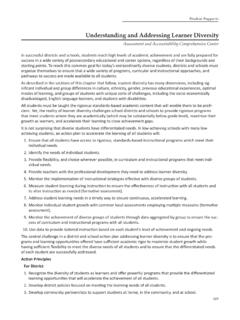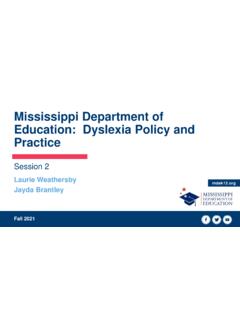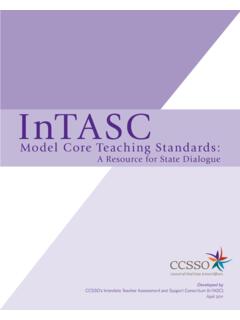Transcription of STUDENT LEARNING GOALS/OBJECTIVES - Connecticut
1 Connecticut STATE DEPARTMENT OF EDUCATION STUDENT LEARNING GOALS/OBJECTIVES 2014 A Handbook for Administrators and Teachers To guide the process for developing high-quality GOALS/OBJECTIVES to improve STUDENT LEARNING Connecticut STATEDEPARTMENT OF EDUCATION Including Sample STUDENT LEARNING GOALS/OBJECTIVES August 6, 2014 Connecticut State Department of Education | State Statute The Connecticut State Department of Education is committed to a policy of equal opportunity/affirmative action for all qualified persons. The Department of Education does not discriminate in any employment practice, education program, or educational activity on the basis of race, color, religious creed, sex, age, national origin, ancestry, marital status, sexual orientation, gender identity or expression, disability (including, but not limited to, mental retardation, past or present history of mental disability, physical disability or LEARNING disability), genetic information, or any other basis prohibited by Connecticut state and/or federal nondiscrimination laws.
2 The Department of Education does not unlawfully discriminate in employment and licensing against qualified persons with a prior criminal conviction. Inquiries regarding the Department of Education s nondiscrimination policies should be directed to Levy Gillespie, Equal Employment Opportunity Director/American with disabilities Act Coordinator, Title IX /ADA/Section 504 Coordinator, State of Connecticut Department of Education, 25 Industrial Park Road, Middletown, CT 06457 860-807-2071. August 6, 2014 Connecticut State Department of Education | 2 Commissioner of Education Stefan Pryor TALENT OFFICE Chief Talent Officer Sarah Barzee, EDUCATOR EFFECTIVENESS AND PROFESSIONAL LEARNING Division Director Shannon Marim n Associate Education Consultant Kimberly Audet Education Consultant Teresa Boyd-Cowles, Education Consultant Sharon Fuller Education Consultant Claudine Primack Education Consultant Kim Wachtelhausen Data Manager Gady Weiner August 6, 2014 Connecticut State Department of Education | 3 Teacher-Leader-in-ResidenceChristopher PoulosTeacher-Leader-in-ResidenceChristo pher ToddCONTENTS INTRODUCTION.
3 5 ADMINISTRATOR STUDENT LEARNING GOALS/OBJECTIVES .. 9 STUDENT LEARNING GOALS/OBJECTIVES Overview ..10 Developing STUDENT LEARNING Indicators Process ..12 Phase 1: Review Data ..13 Phase 2: Set Goals for STUDENT LEARNING ..14 Phase 3: Implementation And Progress Monitoring ..17 Phase 4: Assess Outcomes ..18 Appendices ..20 TEACHER STUDENT LEARNING GOALS/OBJECTIVES ..24 STUDENT LEARNING GOALS/OBJECTIVES Overview ..25 Process for Developing GOALS/OBJECTIVES ..26 Phase 1: Review Data ..28 Phase 2: Set Goals for STUDENT LEARNING ..31 Phase 3: Implement and Monitor Progress Toward Goals ..40 Phase 4: Assess Outcomes ..41 Appendices ..42 August 6, 2014 Connecticut State Department of Education | 4 STUDENT LEARNING GOALS/OBJECTIVES Samples ..47A strong body of evidence now confirms what parents, students , teachers and administrators have long known: effective teachers are among the most important school-level factor in improving STUDENT LEARNING , and effective leadership is an essential component of any successful school (McCaffrey, Lockwood, Koretz, & Hamilton, 2003; Rivkin, Hanushek, & Kain, 2000; Rowan, Correnti & Miller, 2002; Wright, Horn, & Sanders, 1997).
4 Connecticut , like many other states nationwide, has implemented an educator evaluation and support system with the primary goal of developing a talented workforce required to provide a superior education for Connecticut s 21st-century learners Connecticut s Educator Evaluation and Support System clearly defines effective practice, encourages the exchange of accurate, useful information about educator strengths and development areas, and promotes collaboration and shared ownership for professional growth. The evaluation and support system consists of multiple measures to paint an accurate and comprehensive picture of educator performance. Why Develop STUDENT Lea rning Goa ls/Objectives? Creates coherence and aligns practice Tea chers develop their goa ls using the a dministra tor s goa ls a nd da ta of their individua l students to set mea ningful goa ls/objectives tha t will drive STUDENT improvement.
5 Focuses on STUDENT LEARNING By ga thering da ta a nd identifying expected STUDENT outcomes for every STUDENT , school a nd district lea ders, a s well a s tea chers, ca n focus on STUDENT lea rning in wa ys tha t can drive effective instructiona l pra ctice. Reinforces best instructional practices Effective instruction begins with a ssessing STUDENT lea rning needs. Ba sed on tha t a na lysis, a dministra tors a nd tea chers set ta rgeted lea rning goa ls, monitor progress, a ccess professiona l lea rning and monitor instructiona l processes in the cla ssroom. Provides potential for collaboration STUDENT Lea rning Goa ls/Objectives promote colla bora tion a nd reflection of pra ctice a mong educa tors. STUDENT LEARNING GOALS/OBJECTIVES are adaptable STUDENT Lea rning Goa ls/Objectives a re flexible a nd ca n be a djusted or revisited ba sed on cha nges in STUDENT needs ( , la ngua ge proficiency) or shifts in STUDENT population.
6 INTRODUCTION August 6, 2014 Connecticut State Department of Education | 5 The system identifies four components for the evaluation of administrators and four components for the evaluation of teachers as follows: Administrator Teacher STUDENT LEARNING (45%) STUDENT Growth and Development (45%) Stakeholder Feedback (10%) Parent or Peer Feedback (10%) Administrative Performance and Practice (40%), Teacher Performance and Practice (40%) Teacher Effectiveness Outcomes (5%) Whole School STUDENT LEARNING Indicators or STUDENT Feedback (5%) Improving STUDENT achievement sits at the center of the work for all educators. STUDENT LEARNING is a shared responsibility between district leaders, administrators and teachers. When administrators and teachers develop GOALS/OBJECTIVES in a way that supports overall school improvement, opportunities for success have no boundaries.
7 Therefore, there is a reciprocal relationship between the component ratings for the administrator s and the teacher s GOALS/OBJECTIVES . To promote the effectiveness of educational leaders and teachers, this STUDENT LEARNING GOALS/OBJECTIVES Handbook is intended to provide guidance in the development of high-quality STUDENT LEARNING GOALS/OBJECTIVES . This Handbook can be used as a companion to Connecticut s System for Educator Evaluation and Development (SEED), a model evaluation and support system aligned to the Connecticut Guidelines for Educator Evaluation, or to a district developed model for educator evaluation and support. August 6, 2014 Connecticut State Department of Education | 6 Suggested District Timeline 1 Tea chers include classroom and non-classroom educators and service providers.
8 2 All GOALS/OBJECTIVES must be set by November 15. STEP DATE PROCESS 1 End of school year May - Aug Superintendent and Central Office team determine priorities for the district based on trends, patterns and summative data. 2 Prior to the start of the new school year May - Aug Administrator determines priorities for the school and meets with evaluator to establish STUDENT LEARNING indicators based on district and school priorities. Administrator may seek opportunities to collaborate with other administrators in developing GOALS/OBJECTIVES . 3 Aug - Sept Administrator sets the context for teachers STUDENT LEARNING goal/objectives by sharing the district and school priorities and administrator GOALS/OBJECTIVES related to school data. All Teachers1, across all content areas/disciplines, discuss their own contributions to improve STUDENT LEARNING based on school priorities and identified STUDENT needs.
9 4 Sept - Oct2 Teachers examine STUDENT data and set GOALS/OBJECTIVES for STUDENT growth and development utilizing multiple Indicators of Academic Growth and Development (IAGDs). Teachers may seek opportunities to collaboratively set GOALS/OBJECTIVES . Administrator Conducts Goal-Setting Conference: Teacher and evaluator meet to discuss the GOALS/OBJECTIVES in order to arrive at mutual agreement. 5 Oct - Jan Administrator implements his or her strategies to achieve the STUDENT LEARNING indicators, collecting interim data to inform a mid-year conversation with the evaluator. Evaluator also collects evidence to inform the mid-year review, end-of-year summative rating and recommendations for continued improvement. Administrator provides time, resources and professional LEARNING to support teachers in implementing their GOALS/OBJECTIVES .
10 Teachers use effective teaching strategies to implement GOALS/OBJECTIVES and use a formative assessment process to monitor STUDENT progress toward GOALS/OBJECTIVES . Teachers collect evidence to support progress toward GOALS/OBJECTIVES . 6 Jan - Feb Mid-year formative Review: Administrator meets with the evaluator to assess progress toward the STUDENT LEARNING indicators and mutually agree to adjust targets as needed and discuss professional LEARNING needs. Mid-year Check-in Conference: Teacher and evaluator complete at least one mid-year check-in conference to review evidence related to the progress towards GOALS/OBJECTIVES . If needed, teacher and evaluator can mutually agree to revisions on the strategies or approaches used, and/or a mid-year adjustment of the goal/objective to accommodate changes ( , STUDENT populations, teacher assignment, etc.)
